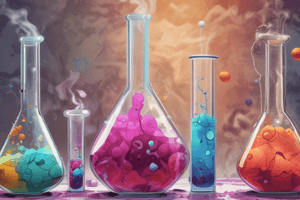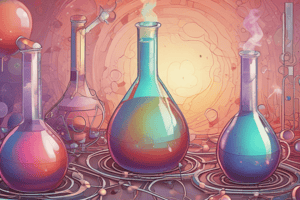Podcast
Questions and Answers
What is the process in which one or more substances are converted into new substances?
What is the process in which one or more substances are converted into new substances?
- Physical change
- Electrolysis
- Nuclear reaction
- Chemical reaction (correct)
Which type of chemical reaction involves the breaking down of a single substance into two or more substances?
Which type of chemical reaction involves the breaking down of a single substance into two or more substances?
- Combustion reaction
- Decomposition reaction (correct)
- Replacement reaction
- Synthesis reaction
What is the purpose of a catalyst in a chemical reaction?
What is the purpose of a catalyst in a chemical reaction?
- To speed up the reaction rate (correct)
- To slow down the reaction rate
- To increase the reaction yield
- To change the reaction mechanism
What is the effect of increasing the concentration of reactants on the reaction rate?
What is the effect of increasing the concentration of reactants on the reaction rate?
What is the reaction mechanism?
What is the reaction mechanism?
What is the purpose of balancing a chemical equation?
What is the purpose of balancing a chemical equation?
What is the effect of increasing the surface area of reactants on the reaction rate?
What is the effect of increasing the surface area of reactants on the reaction rate?
What is an inhibitor in a chemical reaction?
What is an inhibitor in a chemical reaction?
What is the term for a reaction that absorbs energy in the form of heat?
What is the term for a reaction that absorbs energy in the form of heat?
What is the term for the minimum energy required for a reaction to occur?
What is the term for the minimum energy required for a reaction to occur?
What is the purpose of Le Chatelier's Principle?
What is the purpose of Le Chatelier's Principle?
What type of reaction involves the replacement of one element with another in a compound?
What type of reaction involves the replacement of one element with another in a compound?
What is the term for the state where the rates of forward and reverse reactions are equal?
What is the term for the state where the rates of forward and reverse reactions are equal?
What is the effect of increasing the temperature of a reaction?
What is the effect of increasing the temperature of a reaction?
What is the term for a substance that increases the rate of a reaction without being consumed?
What is the term for a substance that increases the rate of a reaction without being consumed?
What type of reaction involves the combination of two or more substances to form a new compound?
What type of reaction involves the combination of two or more substances to form a new compound?
What is the term for the value that represents the ratio of the concentrations of products to reactants at equilibrium?
What is the term for the value that represents the ratio of the concentrations of products to reactants at equilibrium?
What is the term for the rate of reaction at a specific instant?
What is the term for the rate of reaction at a specific instant?
Flashcards are hidden until you start studying
Study Notes
Chemical Reactions
Definition
- A chemical reaction is a process in which one or more substances are converted into new substances
- It involves the breaking and forming of chemical bonds
Types of Chemical Reactions
- Synthesis Reaction: Two or more substances combine to form a new substance
- Example: 2H2 + O2 → 2H2O
- Decomposition Reaction: A single substance breaks down into two or more substances
- Example: 2H2O → 2H2 + O2
- Replacement Reaction: One element replaces another element in a compound
- Example: Zn + CuSO4 → ZnSO4 + Cu
- Combustion Reaction: A substance reacts with oxygen to produce heat and light
- Example: 2CH4 + 3O2 → 2CO2 + 3H2O
Chemical Reaction Equations
- A chemical equation represents a chemical reaction using chemical formulas and symbols
- The reactants are written on the left side, and the products are written on the right side
- The arrow (→) separates the reactants from the products
- Chemical equations can be balanced by ensuring that the number of atoms of each element is the same on both the reactant and product sides
Factors Affecting Chemical Reactions
- Concentration: Increasing the concentration of reactants can increase the reaction rate
- Temperature: Increasing the temperature can increase the reaction rate
- Surface Area: Increasing the surface area of reactants can increase the reaction rate
- Catalysts: Substances that speed up chemical reactions without being consumed or altered
- Inhibitors: Substances that slow down chemical reactions without being consumed or altered
Reaction Rates
- Rate of Reaction: The speed at which a chemical reaction occurs
- ** Factors Affecting Reaction Rate**: concentration, temperature, surface area, catalysts, and inhibitors
- Reaction Mechanism: The step-by-step process by which a chemical reaction occurs
Chemical Reactions
Definition and Characteristics
- Chemical reactions involve the breaking and forming of chemical bonds, resulting in the conversion of one or more substances into new substances.
- Chemical reactions are processes that occur at the molecular level.
Types of Chemical Reactions
Synthesis Reactions
- Occur when two or more substances combine to form a new substance.
- Example: 2H2 + O2 → 2H2O, where hydrogen and oxygen combine to form water.
Decomposition Reactions
- Occur when a single substance breaks down into two or more substances.
- Example: 2H2O → 2H2 + O2, where water breaks down into hydrogen and oxygen.
Replacement Reactions
- Occur when one element replaces another element in a compound.
- Example: Zn + CuSO4 → ZnSO4 + Cu, where zinc replaces copper in copper sulfate.
Combustion Reactions
- Occur when a substance reacts with oxygen to produce heat and light.
- Example: 2CH4 + 3O2 → 2CO2 + 3H2O, where methane reacts with oxygen to produce carbon dioxide and water.
Chemical Reaction Equations
- Represent chemical reactions using chemical formulas and symbols.
- Reactants are written on the left side, and products are written on the right side.
- The arrow (→) separates the reactants from the products.
- Equations can be balanced by ensuring that the number of atoms of each element is the same on both the reactant and product sides.
Factors Affecting Chemical Reactions
Concentration
- Increasing the concentration of reactants can increase the reaction rate.
Temperature
- Increasing the temperature can increase the reaction rate.
Surface Area
- Increasing the surface area of reactants can increase the reaction rate.
Catalysts and Inhibitors
- Catalysts are substances that speed up chemical reactions without being consumed or altered.
- Inhibitors are substances that slow down chemical reactions without being consumed or altered.
Reaction Rates and Mechanisms
- Reaction rate is the speed at which a chemical reaction occurs.
- Factors affecting reaction rate include concentration, temperature, surface area, catalysts, and inhibitors.
- Reaction mechanism is the step-by-step process by which a chemical reaction occurs.
Chemical Reactions
Types of Chemical Reactions
- Synthesis reactions combine two or more substances to form a new compound, such as 2H2 + O2 → 2H2O.
- Decomposition reactions involve a single compound breaking down into two or more simpler substances, such as 2H2O → 2H2 + O2.
- Replacement reactions occur when one element replaces another element in a compound, like Zn + CuSO4 → ZnSO4 + Cu.
- Combustion reactions involve a substance reacting with oxygen to produce heat and light, like 2CH4 + 3O2 → 2CO2 + 3H2O.
- Neutralization reactions involve an acid reacting with a base to form a salt and water, such as HCl + NaOH → NaCl + H2O.
Chemical Reaction Rates
- Concentration, temperature, surface area, and catalysts are factors that affect reaction rates.
- Increasing concentration, temperature, and surface area of reactants increases reaction rate.
- Catalysts increase reaction rate without being consumed or altered.
- Instantaneous rate is the rate of reaction at a specific instant.
- Average rate is the rate of reaction over a period of time.
Chemical Equilibrium
- Equilibrium is a state where the rates of forward and reverse reactions are equal.
- The equilibrium constant (K) represents the ratio of the concentrations of products to reactants at equilibrium.
- Le Chatelier's Principle states that a change in concentration, temperature, or pressure of a system at equilibrium will cause the system to shift towards a new equilibrium state.
Energy Changes in Chemical Reactions
- Exothermic reactions release energy in the form of heat, such as combustion of gasoline.
- Endothermic reactions absorb energy in the form of heat, like photosynthesis.
- Activation energy is the minimum energy required for a reaction to occur.
- Catalysts lower the activation energy, increasing the reaction rate without being consumed or altered.
Studying That Suits You
Use AI to generate personalized quizzes and flashcards to suit your learning preferences.




